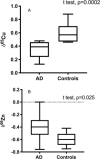Copper and zinc isotopic excursions in the human brain affected by Alzheimer's disease
- PMID: 33102682
- PMCID: PMC7571480
- DOI: 10.1002/dad2.12112
Copper and zinc isotopic excursions in the human brain affected by Alzheimer's disease
Erratum in
-
Erratum.Alzheimers Dement (Amst). 2021 May 2;13(1):e12175. doi: 10.1002/dad2.12175. eCollection 2021. Alzheimers Dement (Amst). 2021. PMID: 33969171 Free PMC article.
Abstract
Introduction: Alzheimer's disease (AD) is neuropathologically marked by amyloid beta (Aβ) plaques and neurofibrillary tangles. Little is known about isotopic compositions of human AD brains. Here we study this in comparison with control subjects for copper and zinc.
Methods: We use mass-spectrometry methods, developed to study extraterrestrial materials, to compare the copper and zinc isotopic composition of 10 AD and 10 control brains.
Results: Copper and zinc natural isotopic compositions of AD brains are statistically different compared to controls, and correlate with Braak stages.
Discussion: The distribution of natural copper and zinc isotopes in AD is not affected by the diet, but is a consequence of Aβ plaques and tau fibril accumulation. This is well predicted by the changes of the chemical bonding environment caused by the development of Aβ lesions and accumulation of tau proteins. Future work will involve testing whether these changes affect brain functions and are propagated to body fluids.
Keywords: Alzheimer's disease; amyloid beta; copper; isotopes.
© 2020 The Authors. Alzheimer's & Dementia: Diagnosis, Assessment & Disease Monitoring published by Wiley Periodicals, LLC on behalf of Alzheimer's Association.
Conflict of interest statement
There are not conflicts of interest.
Figures


References
-
- Miller LM, Wang Q, Telivala TP, Smith RJ, Lanzirotti A, Miklossy J. Synchrotron‐based infrared and X‐ray imaging shows focalized accumulation of Cu and Zn co‐localized with beta‐amyloid deposits in Alzheimer's disease. J Struct Biol. 2006;155:30‐37. - PubMed
-
- Religa D, Strozyk D, Cherny RA, et al. Elevated cortical zinc in Alzheimer disease. Neurology. 2006;67:69‐75. - PubMed
-
- Bush AI. The metallobiology of Alzheimer's disease. Trends Neurosci. 2003;26:207‐214. - PubMed
-
- Roman AY, Devred F, Byrne D, et al. Zinc induces temperature‐dependent reversible self‐assembly of tau. J Mol Biol. 2019;431:687‐695. - PubMed
LinkOut - more resources
Full Text Sources
